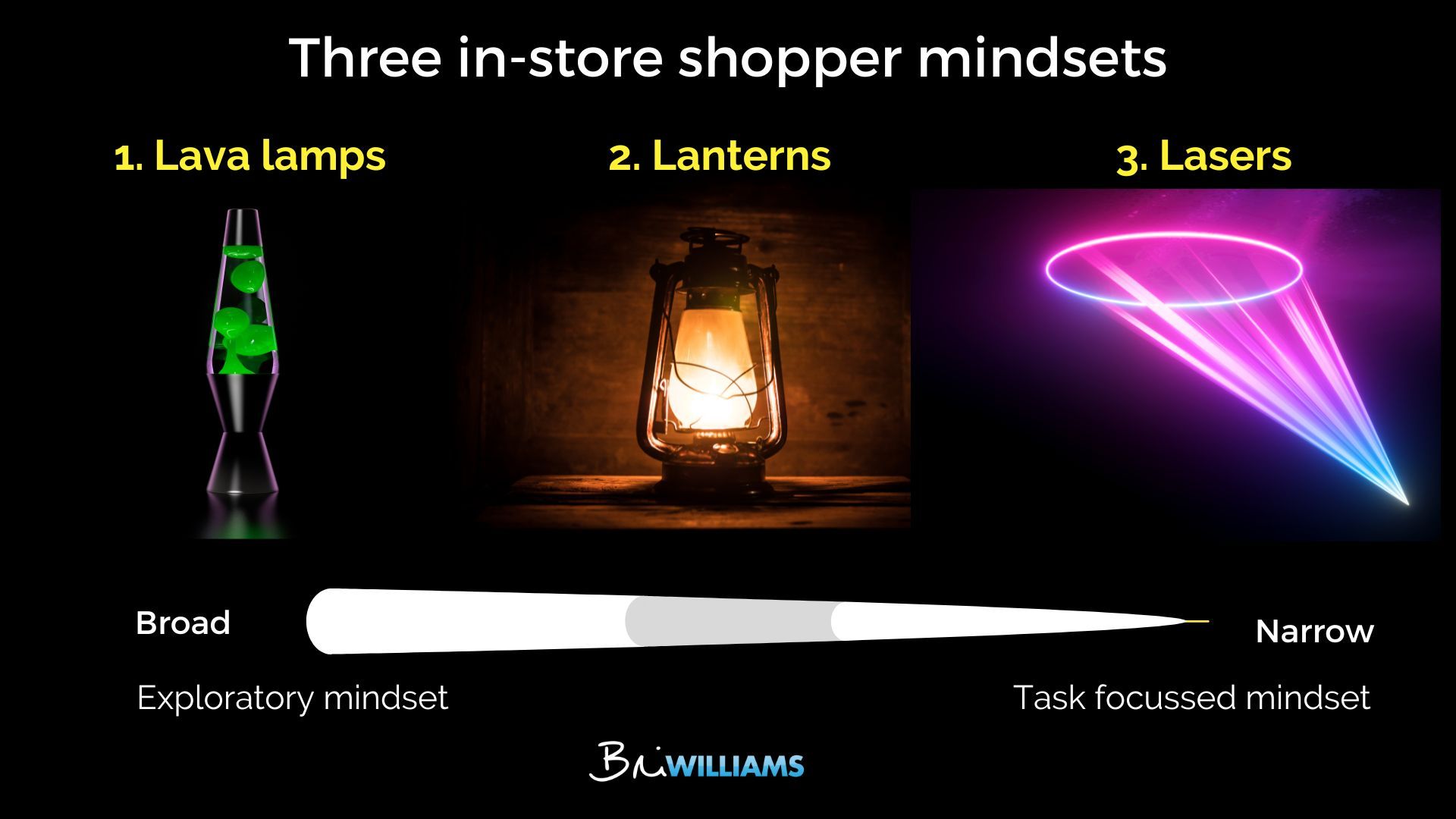Using ego to engage

Ego might be a dirty word, but it’s also a mighty strong sales technique.
Here’s how I fell for it.
Academia, a website housing academic papers across a broad range of fields and journals, sent me this tantalising email.

Game on! Let’s see who’s talking about me!
To access my mentions, I needed to subscribe to their Premium service, which I could do by joining a $1 trial.

So far, so good. I’m one click away from seeing who thinks I’m clever.
But no.
Because trying to search my m...
3 shopper mindsets

I’m preparing for a keynote to a retail group in a couple of weeks, so I’ve been thinking about how they can better engage with in-store shoppers.
As I see it, there are three shopper mindsets that vary according to task orientation:
- Lasers,
- Lanterns and
- Lava Lamps.
I’m using light as the metaphor to represent how diffused their focus is.
At one end of the task orientation scale, Lasers are laser focussed on what they need to buy. They want to get in and get out, so don’t get in...
When to be warm with customers
“Answer your phone in a brusque manner” was advice I got years ago.
By sounding abrupt, the theory was you could dismiss those you didn’t want to talk to, but delight those you did once they heard the contrasting warmth you reserved specially for them.
Well, new research reveals how you can increase customer satisfaction by varying the degree of warmth you and your team use in conversation.
Hot Vs. Cold
Let’s say you are closing a customer service call. Should you say “It was my ple...
The psychology of Chatbots Vs Voice assistants
Is it better to direct your customers to call you or type a response?
While customers may have a preferred method of communicating with you, that should not be your only concern.
👉 It turns out that how they engage with you, via text or voice, may impact their satisfaction with your services.
Matching method to product type
It’s rare these days to visit a website that doesn’t have a chatbot.
While most of these conversational agents are text-based, improvements in voice recognition tec...
When not to use "you" with customers
Did you know you shouldn’t use “you” on your website’s help page, but you should on your home page?
Or that you should only use “we” with some types of customers and “you and us” with others?
Getting personal pronouns like “you, me and we” right is important.
So important that using them in the right way can increase your revenue by up to 7%, and getting them wrong can lose you customers.
In this video, I share which pronouns to use when.
PLUS, you can download a free, exclusive 1 page...
Zebra crossing

There’s a zebra crossing that runs between my two local supermarkets.
To use it, people have to go out of their way about 10 metres.
Instead, a majority run the gauntlet, crossing the busy and chaotic road at a more convenient point.
People on walking frames. People with shopping bags. People with pets and children. Me.
We’re willing to sacrifice safety for convenience.
What’s the trade you are asking people to make?
➡ When it comes to your processes and procedures, are you assuming p...
Don't format a web link like this
Are you making a simple formatting mistake that stops people clicking?
How you format a web link in your emails needs to change according to the relationship you have with the recipient.
If they know you, it’s fine to hyperlink.
If they don’t know you, don’t hyperlink.
For example, because you know me, I can hyperlink like this.
But when I am sending information to a new client, I instead provide the web URL address like this: www.briwillia
How you format a web link in your emails needs...
Wrapping paper
Very young kids are just as happy with the wrapping paper as they are the present.
Sometimes with customers, we think it’s about the present but it’s really the wrapping.
Because the present can’t ever really live up to expectations. Software has bugs. Training has flat spots. Clothes wrinkle.
But how people feel about us?
That lives on.
See: Influencing Action
7 words you should use more often

There are seven words I guarantee you, your customers, and your boss will love.
👉 👉👉 There is nothing you need to do.
Here's an example.
A few weeks ago I received an email from my website host Kajabi.
---
"Hello Bri,
You may have heard about the new email requirements for bulk senders starting February 4, 2024. Yahoo and Gmail have separately announced updated requirements to deliver email to their platforms. Their goal is to better secure customers' inboxes and provide an improved co...
Effective emails

We waste a lot of time writing emails that get ignored, or worse, provoke an unintended response.
So here's how to write emails that work:

First ask, is the news you are sharing with your customer good news or bad news for them?
If it is good news, the tone can be upbeat and positive. If it is bad news, you’ll need to tread more carefully.
Then ask, what do you want them to do as a result of reading your email? Do you want them to do something (action required) or do nothing (no action req...

